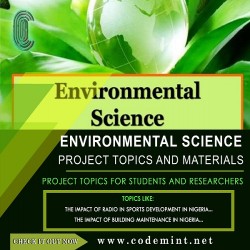- The Complete Research Material is averagely 57 pages long and it is in Ms Word Format, it has 1-5 Chapters.
- Major Attributes are Abstract, All Chapters, Figures, Appendix, References.
- Study Level: BTech, BSc, BEng, BA, HND, ND or NCE.
- Full Access Fee: ₦6,000
Get the complete project »

CHAPTER ONE
INTRODUCTION
Effluent impact on water quality is a point of great concern. This is because, it has been observed that the quality of water people use has a great effect on their health. If proper care is not taken to ascertain the characteristics or composition of the discharged effluent, then environment is exposed to numerous hazards.
One may ask what an effluent really is. An effluent is defined as an industrial liquid waste. It is characterized by the components used in such industries. This implies that the composition or characteristics of effluent varies from industry to industry.
Impact at the other hand is defined as an effect felt as a result of an action taken or a process carried out. It becomes pertinent to carryout Environmental Impact Assessment of possible action to be taken or projects to be carried out. Environmental Impact Assessment (EIA) is defined as a management tool used to assess and evaluate any potential change in the environment (including air, water, land, natural resources, fauna flora, humans and their interaction) whether adverse or beneficial, wholly or partial, that results from an organisations activities, products or services (Ofunne, 2002).
We are really concerned with the effect the discharge of liquid industrial waste (effluent), from Unilever plc and Nigeria Breweries Limited; have on the quality of water obtainable at the river where they are discharged. This impact that is our point of concern is dependent of the various compositions of the effluent and its degree.
Wastewater ought to be collected or a sewer system and transported to plant for treatment prior to disposal (Mark and Mark, 2008). Dilution into a surface water course and purification by nature yield additional quality improvement. The feat of this effluent discharge is that of collecting the water before complete rejuvenation for municipal.
1.1 STATEMENT OF THE PROBLEM
The hazardous effect of the effluent flows from Unilever Plc and Nigeria Breweries Limited to Aba River is our point of concern. This becomes a problem because the waste ought to be channelled to a sewer treatment plant before being discharged finally into the river. This is to help reduce the intensity of the wastewater.
It is therefore pertinent to ascertain the composition of these effluents and relating it with the effect the have on the river quality. This is so because if it not ascertained the environment is exposed to a lot of risk.
1.2 AIMS AND OBJECTIVE
1. To ascertain the level of pollution of the river due to the discharged effluents.
2. To compare the physical, and chemical parameters in the river with the World Health Organizations acceptable standard for drinking water.
3. To suggest or recommend the best ways of discharging effluent in the river.
4. To suggest ways of enforcing the methods of effluent discharge.
1.3 AREA OF STUDY
The project is based on the analysis of the different water samples collected from Aba River in Aba North Local Government Council of Abia State, (where Unilever Plc and Nigeria Breweries Plc discharge their effluent).
1.4 SIGNIFICANCE OF THE STUDY
1. To help bring to the notice of the companies the effect their waste is having in the environment.
2. To proffer solution on the best ways of discharging effluent into rivers.
3. To serve as a reference to all who will handle similar projects in future.
1.5 DEFINITION OF TERMS
Characteristics: General classes of wastewater constituents (wastewater) such as physical, chemical, and biological and biochemical.
Composition: The makeup of wastewater, including physical, chemical and biological constituents.
Constituents: Individual components, elements or biological entities such as suspended solids or ammonia nitrogen.
Contaminants: Constituents added to water through use that pollutes the water.
Disinfection: Reduction of disease-causing micro-organisms by physical or chemical means.
Effluent: Industrial liquid waste or liquid discharged from a processing step.
Impurities: Constituents added to water through use.
Nutrient: An element that is essential for the growth of plants and animals. Nutrients in wastewater, usually Nitrogen and phosphorus, may cause unwanted algal and plant growth in rivers and lakes.
Parameter: Measurable factor such as temperature.
Pollutants: Same as contaminants.
Reclamation: Treatment of wastewater for subsequent reuse application or the act of reusing treated water.
Recycling: The reuse of treated wastewater and bio-solids for beneficial purposes.
Reunification: Treatment of wastewater to a level suitable for a variety of applications including indirect or direct portable reuse.
Reuse: Beneficial use of reclaimed are re-purified wastewater or stabilized bio-solids.
Sludge: Solids removed from wastewater during treatment. Solids that are treated further are called (fermed) biosolids.
Solids: Materials removed from wastewater by gravity separation (by clarifiers, thickeners and lagoons) and is the solid residue from dewatering operations.
You either get what you want or your money back. T&C Apply

You can find more project topics easily, just search
-
SIMILAR ENVIRONMENTAL SCIENCE FINAL YEAR PROJECT RESEARCH TOPICS
-
1. EFFECT OF LITTERED CAN IN THE ENVIRONMENT
» CHAPTER ONE INTRODUCTION 1.1 Background of the study Increasing scenes of trash and its side effect have made the studies on community attitude and li...Continue Reading »Item Type & Format: Project Material - Ms Word | 52 pages |
 Instant Download
|
Chapter 1-5 |
ENVIRONMENTAL SCIENCE DEPARTMENT
Instant Download
|
Chapter 1-5 |
ENVIRONMENTAL SCIENCE DEPARTMENT
-
2. ENVIRONMENTAL PROTECTION AGENCY STRATEGY FOR REDUCING HEALTH RISKS IN URBAN AREAS
» CHAPTER ONE INTRODUCTION 1.1 Background of Study Today, there is no doubt that the world has increasingly become urban and the 20 century witnessed ra...Continue Reading »Item Type & Format: Project Material - Ms Word | 52 pages |
 Instant Download
|
Chapter 1-5 |
ENVIRONMENTAL SCIENCE DEPARTMENT
Instant Download
|
Chapter 1-5 |
ENVIRONMENTAL SCIENCE DEPARTMENT
-
3. EFFECT OF GAS FLARING INTO THE ECOSYSTEM (A CASE STUDY OF NIGER DELTA REGION OF NIGERIA)
» CHAPTER ONE INTRODUCTION 1.1 Background of the study Nigeria flares more natural gas associated with oil extraction than any other country, with estim...Continue Reading »Item Type & Format: Project Material - Ms Word | 60 pages |
 Instant Download
|
Chapter 1-5 |
ENVIRONMENTAL SCIENCE DEPARTMENT
Instant Download
|
Chapter 1-5 |
ENVIRONMENTAL SCIENCE DEPARTMENT
-
4. EVALUATION OF PROBLEMS OF INSUFFICIENT ACCOMODATION TO MILLITARY PERSONNELS (A CASE STUDY OF NIGERIAN ARMY)
» CHAPTER ONE INTRODUCTION 1.1 BACKGROUND TO THE STUDY The Nigerian Armed Forces were established to protect Nigeria against external aggressors and obs...Continue Reading »Item Type & Format: Project Material - Ms Word | 52 pages |
 Instant Download
|
Chapter 1-5 |
ENVIRONMENTAL SCIENCE DEPARTMENT
Instant Download
|
Chapter 1-5 |
ENVIRONMENTAL SCIENCE DEPARTMENT
-
5. MODERNIZATION OF MOMENTUM FOR DEVELOPMENT ( A CASE STUDY OF GBAGYI LAN D IN KADUNA METROPOLIS).
» CHAPTER ONE 1.0 BACKGROUND OF THE STUDY The most accepted account of the origin and the real background of the Gbagyi people, however, say the people ...Continue Reading »Item Type & Format: Project Material - Ms Word | 79 pages |
 Instant Download
|
Chapter 1-5 |
ENVIRONMENTAL SCIENCE DEPARTMENT
Instant Download
|
Chapter 1-5 |
ENVIRONMENTAL SCIENCE DEPARTMENT
-
6. An Assessment Of Solid Waste Disposal Practices In Residential Buildings (A Case Study Of Majidadi 'B' Ward, Bauchi)
» ABSTRACT This research was conducted on “Assessment of Solid Waste Disposal Practices in Majidadi ‘B’ ward in the Bauchi metropolis” aimed at ...Continue Reading »Item Type & Format: Project Material - Ms Word | 56 pages |
 Instant Download
|
Chapter 1-5 |
ENVIRONMENTAL SCIENCE DEPARTMENT
Instant Download
|
Chapter 1-5 |
ENVIRONMENTAL SCIENCE DEPARTMENT
-
7. THE IMPACT OF ZIMPHOS INDUSTRIAL EFFLUENT ON WATER QUALITY. A CASE STUDY OF MUKUVISI RIVER USING AQUATIC MICROFLORA AS BIOINDICATORS.
» ABSTRACT The impact of ZimPhos industrial effluent on the water quality of Mukuvisi River using aquatic microflora indicators was investigated from Ja...Continue Reading »Item Type & Format: Project Material - Ms Word | 82 pages |
 Instant Download
|
Chapter 1-5 |
ENVIRONMENTAL SCIENCE DEPARTMENT
Instant Download
|
Chapter 1-5 |
ENVIRONMENTAL SCIENCE DEPARTMENT
-
8. THE EFFECT OF REFUSED DISPOSAL ON HUMAN HEALTH IN NIGERIA ( A CASE STUDY OF BAYELSA STATE)
» Abstract This research work was carried out on the problems and prospects of waste disposal in Bayelsa state, aimed at providing solution to problems ...Continue Reading »Item Type & Format: Project Material - Ms Word | 52 pages |
 Instant Download
|
Chapter 1-5 |
ENVIRONMENTAL SCIENCE DEPARTMENT
Instant Download
|
Chapter 1-5 |
ENVIRONMENTAL SCIENCE DEPARTMENT
-
9. SHIPPING TRADE AND ITS IMPACT ON ECONOMIC GROWTH IN NIGERIA; 1976-2015
» ABSTRACT The study investigates the impact of Ocean shipment trade on Nigeria’s economic development, covering the period, 1976 2015. Ocean ship...Continue Reading »Item Type & Format: Project Material - Ms Word | 52 pages |
 Instant Download
|
Chapter 1-5 |
ENVIRONMENTAL SCIENCE DEPARTMENT
Instant Download
|
Chapter 1-5 |
ENVIRONMENTAL SCIENCE DEPARTMENT
-
10. DEVELOPING TOURISM VILLAGE FOR EDUCATION AND TOURISM PURPOSES IN KADUNA POLYTECHNIC
» CHAPTER I 1.1 BACKGROUND OF THE STUDY Introduction Tourism is a business activity that caters for the needs of visitors or tourist by producing them w...Continue Reading »Item Type & Format: Project Material - Ms Word | 47 pages |
 Instant Download
|
Chapter 1-5 |
ENVIRONMENTAL SCIENCE DEPARTMENT
Instant Download
|
Chapter 1-5 |
ENVIRONMENTAL SCIENCE DEPARTMENT


